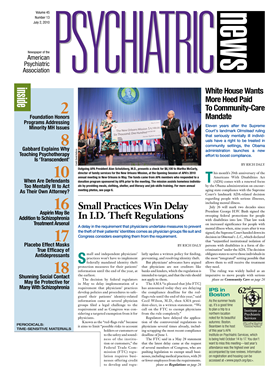Women with substance use disorders (SUDs) do not have the same risk factors, comorbidities, disease course, and treatment response as male patients, and addiction psychiatrists should be mindful of the gender differences. This was the message conveyed by experts at a symposium at APA's 2010 annual meeting in New Orleans in May.
The symposium was part of a track supported by the National Institute on Drug Abuse (NIDA) at the meeting.
Women are traditionally considered to have a much lower prevalence of SUDs than men, but the epidemiology is changing. In 2004, 7.7 million women in the United States were estimated to have alcohol or substance use disorders, according to Kathleen Brady, M.D., a professor of psychiatry and associate dean for clinical research at the Medical University of South Carolina. Alcohol dependence is two to three times more common in men, but the gender gap is smaller for illicit drug dependence at 5.6 percent for women versus 9.2 percent for men. “When it comes to prescription drug misuse or abuse, men and women are about equal,” Brady said.
Among the gender differences are the risk factors for substance abuse. Having a significant other with heavy drinking or drug use problems and having a history of childhood abuse or family violence are very strongly associated with an increased likelihood of substance abuse in women, much more so than in men, according to Brady. The role of childhood trauma appears to be a key risk factor in many women with SUDs.
In addition, Brady cited an abundance of data demonstrating some gender differences in comorbidities: Women with SUDs are more likely to have depressive and anxiety disorders, while men with SUDs are more likely to have attention-deficit/hyperactivity disorder and concurrent alcohol use.
In terms of disease trajectory, telescoping refers to the phenomenon that women appear to progress faster than men from first alcohol and substance use to abuse and to dependence and treatment seeking, Brady said. “In alcohol dependence, we know there are physiological bases that may be underpinning some of the telescoping [effects],” she said. For example, alcohol on average has higher circulating blood levels in women than in men because women tend to be smaller in size, have a lower proportion of body water, and less alcohol dehydrogenase activity. Thus, women are more likely to become intoxicated than men on the same amount of drinking.
Sex Hormones Influence Craving, Relapse
The physiological differences between men and women may help predict treatment response and the risk of relapse as mediated by stress- and cue-induced drug cravings, according to Rajita Sinha, Ph.D., a professor of psychiatry at Yale University School of Medicine.
“Cocaine dependence —and we've shown this also in alcohol—is associated with an enhanced sensitivity to stress- and cue-induced craving, but responses are different by sex and modulated by sex hormones,” she said. In laboratory studies, she found that stress-induced craving is significantly associated with time to relapse in both men and women, but cue-induced craving is associated with time to relapse in women but not in men. In addition, women's brain and biochemical responses to stress appear to differ from men's.
In a pilot study, blood levels of estradiol and progesterone, which fluctuate with a woman's menstrual cycle, appear to influence stress- and cue-induced cravings to cocaine. Women with a high level of estradiol had stronger craving than men, while women with a moderate or high level of progesterone had weaker craving than both men and high-estradiol women.
If these findings are confirmed, treatments that target the stress- and cue-induced craving can be expected to prevent relapse, especially in women.
Women's Group Therapy Shows Promise
Shelly Greenfield, M.D., M.P.H., presented results from stage 1 of the Women's Recovery Group Study funded by NIDA. In this study, adult women with any substance dependence other than nicotine were randomized to either women-only group therapy (n=16) or mixed-gender group therapy (n=17; seven women and 10 men).
Greenfield is the chief academic officer and director of clinical and health services research and education in the Division on Alcohol and Drug Abuse at McLean Hospital and an associate professor of psychiatry at Harvard Medical School.
Both groups received 12 once-weekly therapy sessions, led by female therapists, and were followed for up to six months. Subjects in the mixed-gender group received manual-based behavioral treatment for substance abuse that did not focus on gender-specific issues. In contrast, the women-only group discussed issues and techniques that are related to substance abuse as well as women's concerns, including the effect of drugs and alcohol on women's health; how to manage mood, anxiety, and eating problems without using substances; violence, abuse, and how to get help for them; and how to cope with stress.
Both groups improved significantly from baseline in the 12-week treatment phase, Greenfield reported. However, those in the women-only group maintained their improvement to a greater extent than the women in the mixed-gender group. The patients in the women-only group also reported a higher level of satisfaction with treatment. In addition, women with more severe psychiatric illness and low self-efficacy, as measured by standardized psychological tools, appeared to achieve greater substance use reduction in the women-only group than in the mixed-gender group.
“Certain women with substance use disorders may prefer single-gender [therapy] settings,” said Greenfield. There is research evidence to suggest that the single-gender versus mixed-gender format may influence group process and dynamics, including gender stereotype and cohesion. Based on her study, she noted that “within a single first session, in the all-women context, the amount of fairly sensitive and private information women are able to share with each other early on … is rather remarkable.”

